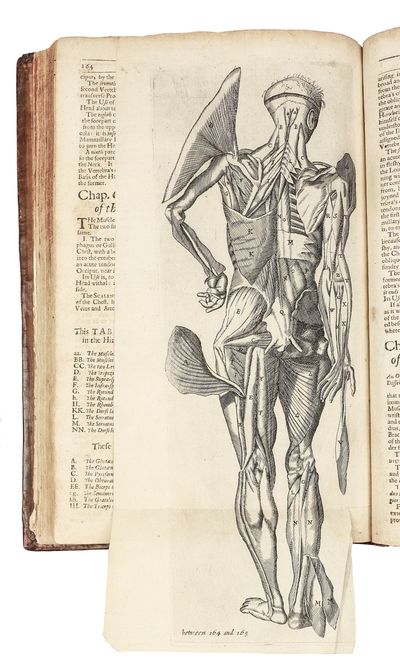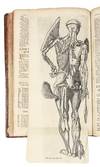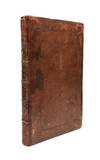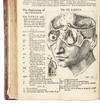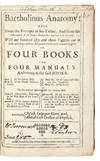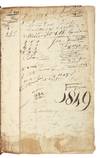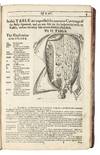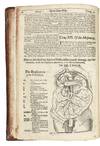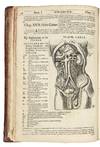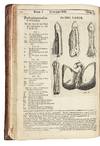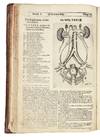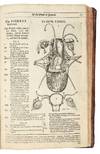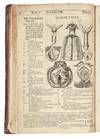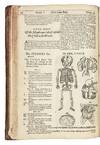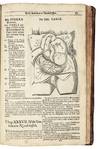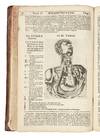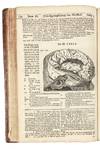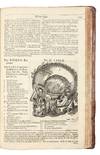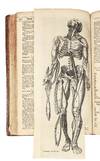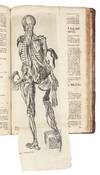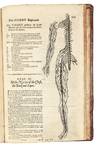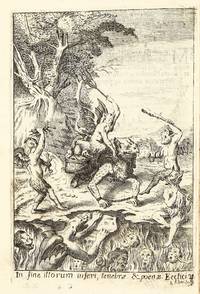Hardcover
1668 · London
by ANATOMY. WOMEN. Bartholin, Thomas (1616-1680); Culpeper, Nicholas (1616-1654)
London: printed by John Streater living in Clerken-well-Close, 1668. FOURTH EDITION. First printed in 1662. Hardcover. Fine. Bound in contemporary blind-ruled calf (some wear and staining, restorations to hinges and corners.) A good copy, clearly oft-consulted, with mild soiling in the text, a number of minor marginal tears (mostly quite small), and a few longer tears, repaired with no loss, including one to the blank margin of one plate (at p. 354). Two front flyleaves torn with loss, advert leaf backed and with long tear mended, small repair to corner of leaf I2.. Numerous nineteenth-century ownership inscriptions on the endpapers and title, including ‘John Smith July 27 1843’, and (probably) the physician John Smith Ashby, from Burton-upon-Stather, Lincolnshire. He annotated the eps and odd leaf in the 1840s. Once he noted a great snow storm, another the arrival of a friend, Gibbon, remarkably from America, and a few times he wrote down recipes for herbal remedies. Illustrated with anatomical engravings throughout the text; with four additional plates tipped in, as called for. Many can be traced to works by Aselli, Bartisch, and Vesalius. A key selling point, the illustrations are advertised in the title: ‘With 153 figures cut in brass, much larger and better than they have been heretofore printed in English’.
Nicholas Culpeper (1616-54) was an English botanist, astrologer, and physician trained at Cambridge. He practised as apothecary in London, whilst publishing influential works in English, including numerous translations, about medical remedies (e.g., the London Dispensatory) and medical astrology; he was later accused of witchcraft. Abdiah Cole (1610-70) was a London physician. ‘Bartholinus’ Anatomy’ brings together theories drawn from the works of the Danish anatomists Caspar Bartholin (1585-1629), author of the standard text ‘Anatomicae Institutiones’ (1611), and his son Thomas (1616-80), who published, in 1652, the first full description of the lymphatic system, as well as ‘observations of all Modern Anatomists’, together with Culpeper’s own theories and observations.
Part I, in 4 books, begins with a chapter on the lower belly, discussing the skin, fat, membranes, abdominal muscles, guts, stomach nerves, intestinal valves, pancreas, liver, spleen, kidneys, bladder, etc. All are accompanied by detailed illustrations with captions identifying each organ, and thoroughly discussed with reference to conditions, physiology (human and animal), and ‘erroneous’ medical theories.
Most interesting is the section on the reproductive organs, with very detailed accounts of their physiology; Culpeper includes Bartholin’s rejection of the theory that the female sex organs are inverted versions of those of the male (isomorphism). The section on the clitoris mentions the practice of female circumcision in eastern Africa. The development of the foetus is described thoroughly. Book II focuses on the middle venter or cavity, i.e., the chest, lungs, heart and throat. Book III discusses the head, i.e., hair, brain, the eyes (with handsome engraved dissections), ears and oral cavity. Book IV is devoted to the limbs and muscles.
The second part is divided into 4 ‘manuals’, each corresponding to one of the four Books. The first focuses on veins (with an engraving clearly inspired by Aselli), valves and the lymphatic system; the second on arteries; the third on the nerves; the fourth on all kinds of head bones and ligaments. Appended are two epistles by Johannes Walaeus to Thomas Bartholinus on the motion of the chyle and the blood, with references to Harvey’s theories and many others, and outstanding engraved illustrations. (Inventory #: 5290)
Nicholas Culpeper (1616-54) was an English botanist, astrologer, and physician trained at Cambridge. He practised as apothecary in London, whilst publishing influential works in English, including numerous translations, about medical remedies (e.g., the London Dispensatory) and medical astrology; he was later accused of witchcraft. Abdiah Cole (1610-70) was a London physician. ‘Bartholinus’ Anatomy’ brings together theories drawn from the works of the Danish anatomists Caspar Bartholin (1585-1629), author of the standard text ‘Anatomicae Institutiones’ (1611), and his son Thomas (1616-80), who published, in 1652, the first full description of the lymphatic system, as well as ‘observations of all Modern Anatomists’, together with Culpeper’s own theories and observations.
Part I, in 4 books, begins with a chapter on the lower belly, discussing the skin, fat, membranes, abdominal muscles, guts, stomach nerves, intestinal valves, pancreas, liver, spleen, kidneys, bladder, etc. All are accompanied by detailed illustrations with captions identifying each organ, and thoroughly discussed with reference to conditions, physiology (human and animal), and ‘erroneous’ medical theories.
Most interesting is the section on the reproductive organs, with very detailed accounts of their physiology; Culpeper includes Bartholin’s rejection of the theory that the female sex organs are inverted versions of those of the male (isomorphism). The section on the clitoris mentions the practice of female circumcision in eastern Africa. The development of the foetus is described thoroughly. Book II focuses on the middle venter or cavity, i.e., the chest, lungs, heart and throat. Book III discusses the head, i.e., hair, brain, the eyes (with handsome engraved dissections), ears and oral cavity. Book IV is devoted to the limbs and muscles.
The second part is divided into 4 ‘manuals’, each corresponding to one of the four Books. The first focuses on veins (with an engraving clearly inspired by Aselli), valves and the lymphatic system; the second on arteries; the third on the nerves; the fourth on all kinds of head bones and ligaments. Appended are two epistles by Johannes Walaeus to Thomas Bartholinus on the motion of the chyle and the blood, with references to Harvey’s theories and many others, and outstanding engraved illustrations. (Inventory #: 5290)
